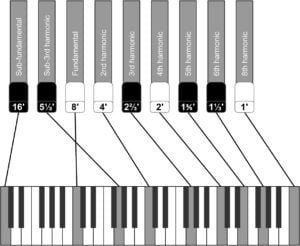
The drawbars on a console Hammond (B3, C3 or A100 and variants) and the clone wheels can be a source of much confusion. They are also sometimes called tone bars, and they are used to shape the sound.
Each drawbar is marked with a number in feet. As an example, the first (brown) drawbar is marked 16′. This terminology is borrowed from pipe organ technology, where this number actually describes the length of the pipe that is used to get a certain tone.
Every drawbar has eight settings, which indicate how much of a particular drawbar’s tone is added to the final signal, with 1 being the softest, and 8 being the loudest. When the drawbar is pushed in all the way, no sound from this drawbar is used in the final sound.
On a console, you will have five groups of drawbars, two for the lower manual and two for the upper manual, each of which consist of none drawbars, and one for the bass, which has two drawbars.
Drawbar colours
There are three different colours on the drawbars, brown, white and black.
The fundamental, ‘core’ tone is created by the first white drawbar. The other white drawbars are octave intervals of the fundamental tone of increasingly higher pitched notes.
The brown drawbars are the two ones to the left, and these produce harmonics below the fundamental tone. The first brown Drawbar is the sub-octave of the fundamental Drawbar. It is “one octave” lower in sound. The second brown drawbar is the “sub-octave” of the third harmonic. Pulling the brown drawbars makes the tone deeper and fuller.
The black drawbars introduce dissonant harmonics, which serve to color the tone and give it character.
